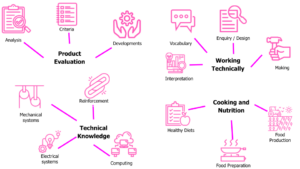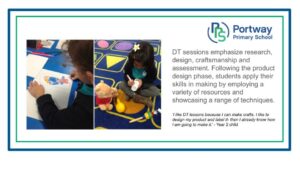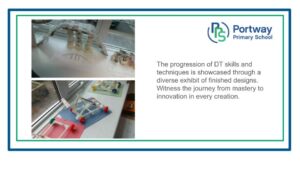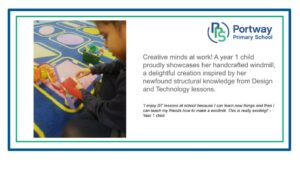Design and Technology
Design and technology is an inspiring, rigorous and practical subject at Portway Primary. The curriculum allows opportunities for pupils to use their creativity and imagination, to design and make products that solve real and relevant problems within a variety of contexts, considering their own and others’ needs, wants and values. Pupils acquire a broad range of subject knowledge and draw on disciplines such as Maths, Science, Computing and Art. Pupils learn to take risks, becoming resourceful, innovative and enterprising. Through the evaluation of past and present design and technology, they develop a critical understanding of its impact on daily life and the wider world.
Our Design and Technology Curriculum develops essential characteristics of designers:
- Significant levels of originality and the willingness to take creative risks to produce innovative ideas and prototypes.
- An excellent attitude to learning and independent working.
- The ability to use time efficiently and work constructively and productively with others.
- The ability to carry out thorough research, show initiative and ask questions to develop an exceptionally detailed knowledge of users’ needs.
- The ability to act as responsible designers and makers, working ethically, using finite materials carefully and working safely.
- A thorough knowledge of which tools, equipment and materials to use to make their products.
- The ability to apply mathematical knowledge.
- The ability to manage risks exceptionally well to manufacture product safely and hygienically.
- A passion for the subject and knowledge of up-to-date technological innovations in materials, products and systems.
Our design and technology unit coverage provides detailed information as to how we teach all elements of the curriculum across all year groups at our school.
How is design and technology taught at Portway?
The Design and Technology curriculum is designed to help pupils form a Design and Technology Mental model within their long-term memories.
Schema theory states that all knowledge is organised into units. A mental model is, therefore, a conceptual system for understanding knowledge.
Our Design and Technology Mental model is a way of organising Design and Technology substantive and disciplinary knowledge in a meaningful way; it is an appreciation of how facts are connected and the ways in which they are connected. It is distinct from information, which is just isolated facts that have no organisational basis or links.
Big Ideas help form the basis of the mental model. Big Ideas are key concepts that underpin the subject. There are four Big Ideas in Design and Technology:
- Product Evaluation (Appreciating that designers take inspiration from existing products – natural or manufactured- and use them as starting points for their design)
- Technical knowledge (Demonstrating the skills needed to make high-quality products)
- Cooking and Nutrition (An awareness of where food originates and how it is processed in preparation for consumption. Start to develop basic cooking skills in a safe environment
- Working Technically (Understanding the design process of ‘think, make, break, repeat’)
Each Big Idea has knowledge strands which help to strengthen the mental model. Learning knowledge in each of the strands allows pupils to express and demonstrate their understanding of the Big Idea, which gradually develops as pupils return to them over and over again.

What makes design and technology unique at Portway?



